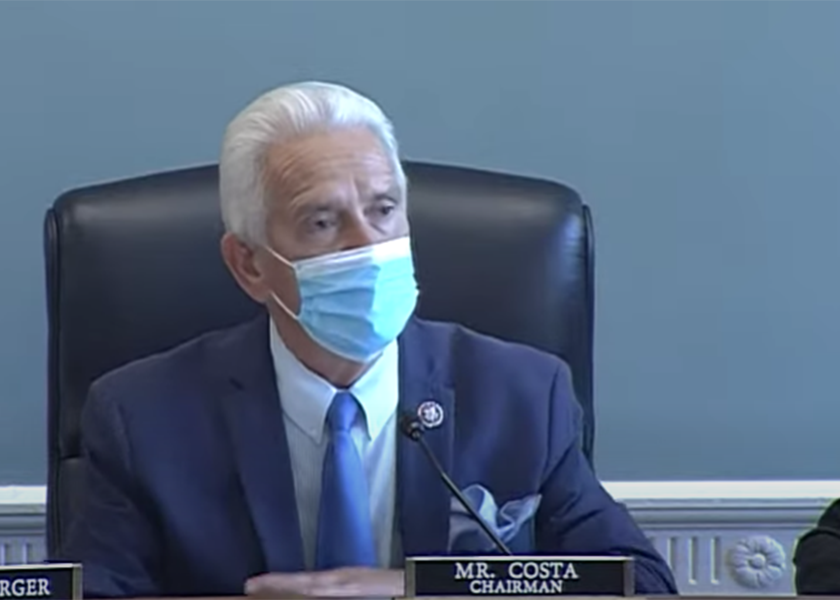House Ag Committee Takes a Turn Tackling Beef Supply Chain Issues

Following the Senate Ag Committee hearing on anti-competitive practices, transparency and other issues in the beef cattle market last month, the House Ag Committee’s subcommittee on Livestock and Foreign Agriculture held its own hearing to discuss shocks to the supply chain and how to support livestock producers on July 28, titled “State of the Beef Supply Chain: Shocks, Recovery, and Rebuilding.”
In his opening remarks, committee chair Rep. Jim Costa (D-Calif.) detailed the largest “Black Swan” events that have affected the cattle industry one after another, starting with the Tyson plant fire in Holcomb, Kan., followed by the COVID-19 pandemic and then the cyberattack on JBS.
“It is our job on this subcommittee to get to the bottom of the most complex challenges confronting agriculture and to help our farmers and ranchers overcome these challenges,” Costa said. “Today we will hear from four expert witnesses, who will tell us where the vulnerabilities in our supply chain lie and share their innovative ideas for helping the beef supply chain adapt to become more resilient, so that we can use what we learn today to create positive change.”
Witness testimony came from Dr. Jayson Lusk, Distinguished Professor and Head of the Department of Agricultural Economics, Purdue University; Dr. Jennifer van de Ligt, Director, Food Protection and Defense Institute, University of Minnesota; Dr. Keri Jacobs, Associate Professor of Ag & Applied Economics, Division of Applied Social Sciences, College of Agriculture, Food and Natural Resources, University of Missouri and Dr. Dustin Aherin, Vice President and Rabo Research Animal Protein Analyst, Rabo AgriFinance.
Lusk’s testimony focused on the historical background of cattle prices and volatility, and how that has been impacted and influenced by the most recent events and what is needed in the future.
“There is a key lesson to take from this recent historical episode. There are long lags and ripple effects in cattle and beef markets. A producer makes a decision today to breed a cow and it will be roughly three years until the resulting offspring is ready for market. Likewise, investors today decide to build a new packing plant. It will be years before construction is finished and the capacity is brought online,” Lusk says. “Everyone is betting on the future with information that will ultimately be two to three years old by the time outcomes are realized. Cattle inventories have already started to fall, and cattle prices have risen since last summer. My recommendation to you, as policy makers, is the following: do not overly focus on what is happening today. Consider what will be needed three to five years from now.”
Van de Ligt testified on the cyber risk in the food and agriculture sector and the growing dependence on cyber information and operation systems to perform a growing number of normal operating systems. This ranges from email to data storage and records retention, to point of sale activities, and lately control systems in meat harvesting plants and sensors that monitor the temperature and pasteurization of milk.
“Regardless of why cyber risk exists, cyberattacks have the potential to cause catastrophic disruption and endanger national security concerns,” Van de Ligt said. “The recent JBS cyberattack disrupted meat procession operations in several countries and simultaneously caused disruptions to supply chains, logistics and transportation to customers. And it increased consumer prices. This amplification of disruption can easily result in national security threats depending on the scale of attack and subsequent disruption.”
Jacobs testified to potential solutions, including:
> USDA research into minimum efficient scale in beef processing and what’s needed to achieve it
> Temporarily subsidizing evidence-based scalable capacity
> Creating a loan guarantee program to reduce risks to lenders for producer-owned finishing, processing, and marketing and that financing being available earlier in the investment period
> Preserving niche-market products
> Providing technical assistance for producers to form cooperatives or associations and gain traction in the startup period and coordination with downstream partners.
Aherin shared perspective from the strategic decision-making angle for the bank and the bank’s clients through research-based perspective on market dynamics and future trends.
The National Cattlemen’s Beef Association (NCBA) applauded the willingness of the committee to prioritize these issues and help cattle producers.
“The roadblocks that are depressing profits for our cattle producers and endangering the steady supply of affordable beef have really captured the attention of lawmakers," said NCBA vice president of government affairs Ethan Lane. "The continued momentum we are seeing on expanding processing capacity, both on Capitol Hill and at USDA, is a positive sign. We are grateful to Chairman Costa and Ranking Member Johnson for prioritizing this issue. We look forward to continuing to work with members of the House Agriculture Committee to advance solutions like the Butcher Block Act that would alleviate some of the chokepoints that are hurting our producers."
The United States Cattlemen’s Association (USCA) pledges to work with both the Senate and House on these issues, as well as urging its members to contact their elected officials to lend further support.
“USCA will work with members of both the Senate and House to advance transparency and true price discovery, truth in labeling, protecting the health of the domestic cattle herd, free AND fair trade, increasing opportunities for success for independent beef processors, and more,” it said.
Wednesday’s house hearing came just hours before the Senate Judiciary Committee hearing on the supply chain, which included testimony from packers, grocers and other industry representatives.
The full hearing is available to watch here.
Related:
Sen. Judiciary Committee Puts America’s Food Supply Chain On Stage
Grassley: Beef Producers Face a “Very Unfair Situation”
Accusations Of Anti-Competitive Practices In The Cattle Industry Drive Senate Ag Committee Hearing
NCBA’s Lane Discusses Senate Hearing, Small and Medium Packing Plant Expansion Efforts







